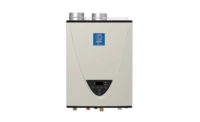The market for tankless water heaters continues to expand. At the same time, the market continues to become more connected, literally and figuratively.
Manufacturers such as Intellihot, Navien, Noritz, A. O. Smith and Bosch continue to evolve their products with options such as Wi-Fi technology and mobile apps, rack systems for easier cascading of multiple units, and of course, greater controls for installers and users.
Intellihot recently debuted its Tellibot technology which can transform any water heater or boiler into a smart device and monitor the boiler room for safety. Intellihot founder and CEO Sri Deivasigamani believes connectivity is critical for the commercial market because it makes building managers’ lives and jobs easier.
“Water heaters, much like many other industries, are moving toward ease of control and visibility of information to the end user no matter where they are — whether inside the building or thousands of miles away,” he says.
Bradford White has started to make waves in the commercial markets with a kit that allows for its residential tankless units to be adapted for use in light commercial applications. Chad Sanborn, a product marketing manager for Bradford White, says the kit is basically a control override.
“You swap out the control and you’re allowed to set the unit to the 184° F set point,” he says. “It normally is capped at 140°. Once it is overridden you can’t turn the temperature back down.”
Sanborn reports the restaurant market has been a moderate success with the adapter kit. He believes Bradford White will continue to slowly grow its commercial business.
“I won’t put a timetable on it, but I believe we will come out with some new SKUs for the commercial market,” he says. “The market for tankless is growing and we are watching it closely.”
Your voice matters
Matt Schulz, A. O. Smith’s senior manager of commercial new product development, says the company is focused on its condensing product line, with its 199,000 Btu/h model being the most popular.
“It now utilizes copper alloy for the heat-exchanger tubing,” he explains. “This material has proven to provide the reliability and performance required in more demanding commercial applications.”
Schulz also notes engineers and the specifying community have been integral for A. O. Smith in research and development.
“Many of our new product ideas and insights come from working closely with specifying engineers,” he notes. “We find commercial building owners are asking many engineers for tankless units, resulting in engineers reaching out to us for information and recommendations on applying tankless in commercial applications.”
Navien Specialty Channel Sales Manager Brian Fenske enjoys meeting with engineers while he’s on the road to pick up ideas for his company.
“Engineer office visits, lunch and learns, association meetings as well as trade shows have been a focus for us,” he notes. “It assists us with education, design and application collaboration.”
Time marches on
Eric Manzano, an engineering training specialist with Noritz, can see a day where larger commercial applications, such as a hospital, can use the technology. It will take some more innovation and expansion, but it is possible.
“I could see where our heaters would be used in a (hospital) application or where temperature control is important,” he states. “That is the goal with tankless. We work very hard on our heat exchangers to provide stability to those temperatures.”
Manzano adds: “Having that management system, where it is on an app or integrated into the whole building analysis (is key). Having those tools available, we can provide energy analysis and energy-saving tips to reduce waste.”
Chas Kerin, an engineer trainer with Bosch, points out the new 9000 Series tankless water heater is the company’s latest innovation for the market. Bosch soon will release its 9800 model — a 199,000 Btu/h option for commercial applications.
“It will actively drive and monitor the pump via the software for the unit,” Kerin says. “That will be a huge advantage regarding tank loading. It will determine when the circulator turns on. We will be looking at an energy factor of .99.”
Fenske sees the commercial tankless market advancing so it is faster for engineers and contractors to make the decision to go with tankless for a commercial project.
“Quick and easy adaption and change out of all types of domestic hot water systems is key to tankless successes,” he says. “Ready-made racks, installation kits, venting kits and control interfacing will be a large part of the future.”
Schulz adds: “There is great opportunity for new technology and ease of retrofit to improve venting in the replacement market place.”
Deivasigamani says the evolution of the water heater market is only going to pick up steam and move at a much faster pace.
“There is a confluence of owning and operating cost, reliability and size of equipment,” he says. “This has been fueled by modular technology coupled with the ‘Internet of Things,’ or IoT as it is more popularly known. The domestic hot-water heating market is heading into a new age. We expect more changes in the next 10 years than what has happened in the last 100 years of water heating.”
Mike Miazga, editor of pme’s sister publication Supply House Times, added additional reporting for this story.






